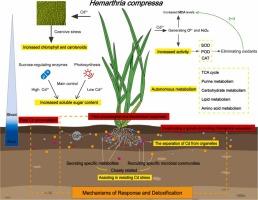通过代谢组学和微生物组学分析,阐明了低镉积累植物河茅对镉胁迫的解毒机制
IF 11.3
1区 环境科学与生态学
Q1 ENGINEERING, ENVIRONMENTAL
引用次数: 0
摘要
镉(Cd)被认为是环境中毒性最大的重金属之一,可引起明显的植物毒性。研究了不同镉胁迫浓度(0、30、60、90和270 mg·kg-1)下,压血毒蛾的生理生化反应及其解毒机制。研究结果表明,在Cd浓度为60 mg·kg-1时,压缩水杨的生长和光合能力达到峰值。在该浓度下,白杨茎部Cd浓度为0.67 mg·kg-1, Cd累积总量为0.25 μg, MDA含量为6.25 nmol·g-1,是各处理中最低的。代谢组学分析表明,糖与镉胁迫抗性有关,参与代谢过程的有机酸水平仅发生微小变化。压缩植物通过分泌大量有机酸(如柠檬酸、富马酸和苹果酸)、糖(如海藻糖、麦芽糖和葡萄糖)和脂肪酸(如柠檬酸)来改变其根部分泌物的组成。这些有机酸调节根际土壤的pH值,招募有益微生物,包括Gp6、Sphingoaurantiacus、Devosia和Neobacillus等,从而促进植物生长,减轻Cd积累。本文章由计算机程序翻译,如有差异,请以英文原文为准。

Metabolomics and microbiome analysis elucidate the detoxification mechanisms of Hemarthria compressa, a low cadmium accumulating plant, in response to cadmium stress
Cadmium (Cd) is recognized as one of the most toxic heavy metal in the environment that causes pronounced phytotoxicity. This study investigated the physiological and biochemical responses and detoxification mechanisms of Hemarthria compressa under various concentrations of Cd stress (0, 30, 60, 90, and 270 mg·kg-1). Our research findings indicate that the growth and photosynthetic capacity of H. compressa reach their peak at a Cd concentration of 60 mg·kg-1. At this concentration, the Cd concentration in the shoots of H. compressa is 0.67 mg·kg-1, the total Cd accumulation is 0.25 μg, and the MDA content is 6.25 nmol·g-1, which represents the lowest values among all treatments.Metabolomics analysis reveals that sugar is related to Cd stress resistance, and the levels of organic acids involved in metabolic processes show only minor changes. H. compressa alters the composition of its root exudates by secreting substantial quantities of organic acids (such as citric acid, fumaric acid, and malic acid), sugars (such as trehalose, maltose, and glucose), and fatty acids (such as citraconic acid). These organic acids modulate the pH of the rhizosphere soil and recruit beneficial microorganisms, including Gp6, Sphingoaurantiacus, Devosia, and Neobacillus species, thereby enhancing plant growth and mitigating Cd accumulation.
求助全文
通过发布文献求助,成功后即可免费获取论文全文。
去求助
来源期刊

Journal of Hazardous Materials
工程技术-工程:环境
CiteScore
25.40
自引率
5.90%
发文量
3059
审稿时长
58 days
期刊介绍:
The Journal of Hazardous Materials serves as a global platform for promoting cutting-edge research in the field of Environmental Science and Engineering. Our publication features a wide range of articles, including full-length research papers, review articles, and perspectives, with the aim of enhancing our understanding of the dangers and risks associated with various materials concerning public health and the environment. It is important to note that the term "environmental contaminants" refers specifically to substances that pose hazardous effects through contamination, while excluding those that do not have such impacts on the environment or human health. Moreover, we emphasize the distinction between wastes and hazardous materials in order to provide further clarity on the scope of the journal. We have a keen interest in exploring specific compounds and microbial agents that have adverse effects on the environment.
 求助内容:
求助内容: 应助结果提醒方式:
应助结果提醒方式:


